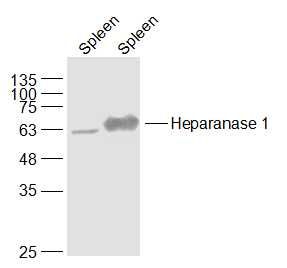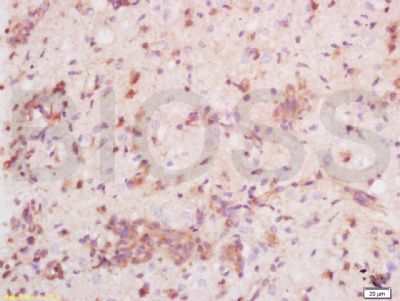产品中心
当前位置:首页>产品中心Anti-Heparanase 1
货号: bs-1541R 基本售价: 780.0 元 规格: 50ul
- 规格:50ul
- 价格:780.00元
- 规格:100ul
- 价格:1380.00元
- 规格:200ul
- 价格:2200.00元
产品信息
- 产品编号
- bs-1541R
- 英文名称
- Heparanase 1
- 中文名称
- 乙酰肝素酶抗体
- 别 名
- Heparanase 50 kDa subunit; heparanase; heparanase1; heparanase-1; heparanase 1; Endo glucoronidase; Endo glucoronidase; Endo-glucoronidase; HPSE_HUMAN; Heparanase1; Heparanase 1; HEP; Hpa 1; HPA; Hpa1; HPR 1; HPR1; HPSE 1; HPSE; HPSE1; HSE 1; HSE1.
- 规格价格
- 50ul/780元购买 100ul/1380元购买 200ul/2200元购买 大包装/询价
- 说 明 书
- 50ul 100ul 200ul
- 研究领域
- 肿瘤 免疫学
- 抗体来源
- Rabbit
- 克隆类型
- Polyclonal
- 交叉反应
- Human, Mouse, Rat, Dog, Pig, Horse,
- 产品应用
- WB=1:500-2000 ELISA=1:500-1000 IHC-P=1:400-800 IHC-F=1:400-800 IF=1:100-500 (石蜡切片需做抗原修复)
not yet tested in other applications.
optimal dilutions/concentrations should be determined by the end user.
- 分 子 量
- 43kDa
- 细胞定位
- 细胞核 细胞浆 细胞膜 分泌型蛋白
- 性 状
- Lyophilized or Liquid
- 浓 度
- 1mg/ml
- 免 疫 原
- KLH conjugated synthetic peptide derived from human Heparanase 50 kDa subunit:141-240/543
- 亚 型
- IgG
- 纯化方法
- affinity purified by Protein A
- 储 存 液
- 0.01M TBS(pH7.4) with 1% BSA, 0.03% Proclin300 and 50% Glycerol.
- 保存条件
- Store at -20 °C for one year. Avoid repeated freeze/thaw cycles. The lyophilized antibody is stable at room temperature for at least one month and for greater than a year when kept at -20°C. When reconstituted in sterile pH 7.4 0.01M PBS or diluent of antibody the antibody is stable for at least two weeks at 2-4 °C.
- PubMed
- PubMed
- 产品介绍
- background:
Heparanase is an endo-beta-D-glucuronidase, which degrades heparan sulfate side chains of heparan sulfate proteoglycans (HSPGs) in the extracellular matrix. Heparanase plays an important role in ECM degradation, facilitating the migration and extravasations of tumor cells and inflammatory leukocytes. Upon degradation, heparanase releases growth factors and cytokines that stimulate cell proliferation and chemotaxis. Heparanase is a heterodimer comprised of a 50 kDa subunit harboring the active site and an 8 kDa subunit. It is produced as a latent 65 kDa precursor and proteolytically processed to its active form. Heparanase is highly expressed in myeloid leukocytes (i.e. neutrophils) in platelets and in human placenta. Human heparanase was found to be upregulated in various types of primary tumors, correlating in some cases with increased tumor invasiveness and vascularity and with poor prospective survival.
Function:
Endoglycosidase that cleaves heparan sulfate proteoglycans (HSPGs) into heparan sulfate side chains and core proteoglycans. Participates in extracellular matrix (ECM) degradation and remodeling. Selectively cleaves the linkage between a glucuronic acid unit and an N-sulfo glucosamine unit carrying either a 3-O-sulfo or a 6-O-sulfo group. Can also cleave the linkage between a glucuronic acid unit and an N-sulfo glucosamine unit carrying a 2-O-sulfo group, but not linkages between a glucuronic acid unit and a 2-O-sulfated iduronic acid moiety. It is essentially inactive at neutral pH but becomes active under acidic conditions such as during tumor invasion and in inflammatory processes. Facilitates cell migration associated with metastasis, wound healing and inflammation. Enhances shedding of syndecans, and increases endothelial invasion and angiogenesis in myelomas. Acts as procoagulant by increasing the generation of activation factor X in the presence of tissue factor and activation factor VII. Increases cell adhesion to the extacellular matrix (ECM), independent of its enzymatic activity. Induces AKT1/PKB phosphorylation via lipid rafts increasing cell mobility and invasion. Heparin increases this AKT1/PKB activation. Regulates osteogenesis. Enhances angiogenesis through up-regulation of SRC-mediated activation of VEGF. Implicated in hair follicle inner root sheath differentiation and hair homeostasis.
Subunit:
Heterodimer; heterodimer formation between the 8 kDa and the 50 kDa subunits is required for enzyme activity. Interacts with TF; the interaction, inhibited by heparin, enhances the generation of activated factor X and activates coagulation. Interacts with HRG; the interaction is enhanced at acidic pH, partially inhibits binding of HPSE to cell surface receptors and modulates its enzymatic activity. Interacts with SDC1; the interaction enhances the shedding of SDC1.
Subcellular Location:
Lysosome membrane; Peripheral membrane protein. Secreted. Nucleus. Note=Proheparanase is secreted via vesicles of the Golgi. Interacts with cell membrane heparan sulfate proteoglycans (HSPGs). Endocytosed and accumulates in endosomes. Transferred to lysosomes where it is proteolytically cleaved to produce the active enzyme. Under certain stimuli, transferred to the cell surface. Associates with lipid rafts. Colocalizes with SDC1 in endosomal/lysosomal vesicles. Accumulates in perinuclear lysosomal vesicles. Heparin retains proheparanase in the extracellular medium.
Tissue Specificity:
Highly expressed in placenta and spleen and weakly expressed in lymph node, thymus, peripheral blood leukocytes, bone marrow, endothelial cells, fetal liver and tumor tissues. Also expressed in hair follicles, specifically in both Henles and Huxleys layers of inner the root sheath (IRS) at anagen phase.
Post-translational modifications:
Proteolytically processed. The cleavage of the 65 kDa form leads to the generation of a linker peptide, and 8 kDa and 50 kDa products. The active form, the 8/50 kDa heterodimer, is resistant to degradation. Complete removal of the linker peptide appears to be a prerequisite to the complete activation of the enzyme.
N-glycosylated. Glycosylation of the 50 kDa subunit appears to be essential for its solubility.
Similarity:
Belongs to the glycosyl hydrolase 79 family.
SWISS:
Q9Y251
Gene ID:
10855
Database links:Entrez Gene: 10855 Human
Entrez Gene: 15442 Mouse
Entrez Gene: 64537 Rat
Omim: 604724 Human
SwissProt: Q9Y251 Human
SwissProt: Q6YGZ1 Mouse
SwissProt: Q8K3K3 Mouse
SwissProt: Q71RP1 Rat
SwissProt: Q9QZF8 Rat
Unigene: 44227 Human
Unigene: 265786 Mouse
Unigene: 6392 Rat
Important Note:
This product as supplied is intended for research use only, not for use in human, therapeutic or diagnostic applications.
乙酰肝素酶(heparanase)在血管形成、炎性反应、组织生长发育及肿瘤转移的过程中起着重要作用。在正常情况下,乙酰肝素酶的分泌和活性必须受到严格的调控,以免其表达对细胞外基质错误切割造成组织损伤而发生各种病理改变。
- 产品图片
 Sample:
Sample:
Spleen (Mouse) Lysate at 40 ug
Spleen (Rat) Lysate at 40 ug
Primary: Anti-Heparanase 1 (bs-1541R) at 1/1000 dilution
Secondary: IRDye800CW Goat Anti-Rabbit IgG at 1/20000 dilution
Predicted band size: 43 kD
Observed band size: 63 kD Tissue/cell: human glioma tissue; 4% Paraformaldehyde-fixed and paraffin-embedded;
Tissue/cell: human glioma tissue; 4% Paraformaldehyde-fixed and paraffin-embedded;
Antigen retrieval: citrate buffer ( 0.01M, pH 6.0 ), Boiling bathing for 15min; Block endogenous peroxidase by 3% Hydrogen peroxide for 30min; Blocking buffer (normal goat serum,C-0005) at 37℃ for 20 min;
Incubation: Anti-Heparanase Polyclonal Antibody, Unconjugated(bs-1541R) 1:200, overnight at 4°C, followed by conjugation to the secondary antibody(SP-0023) and DAB(C-0010) staining

